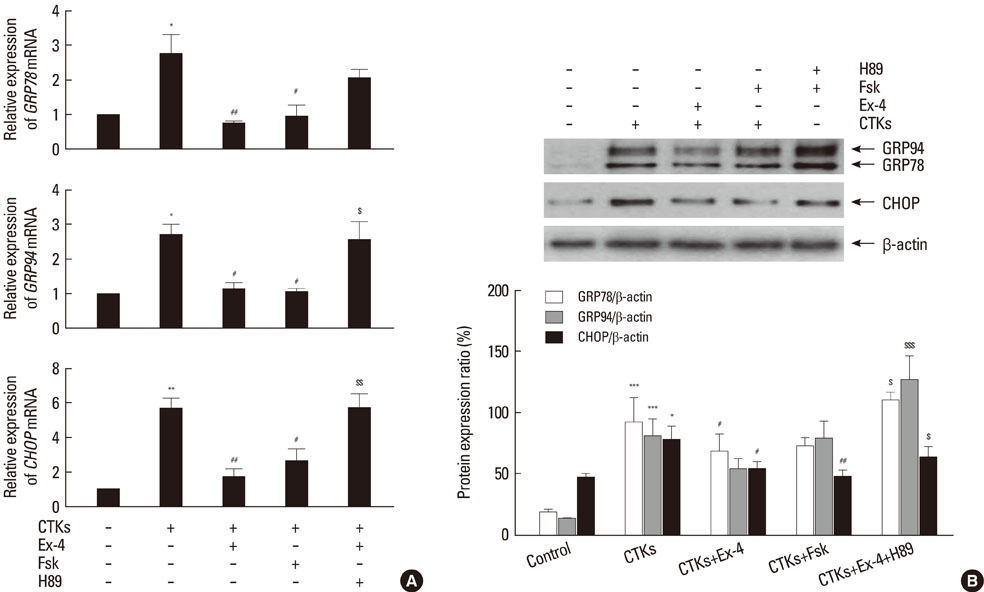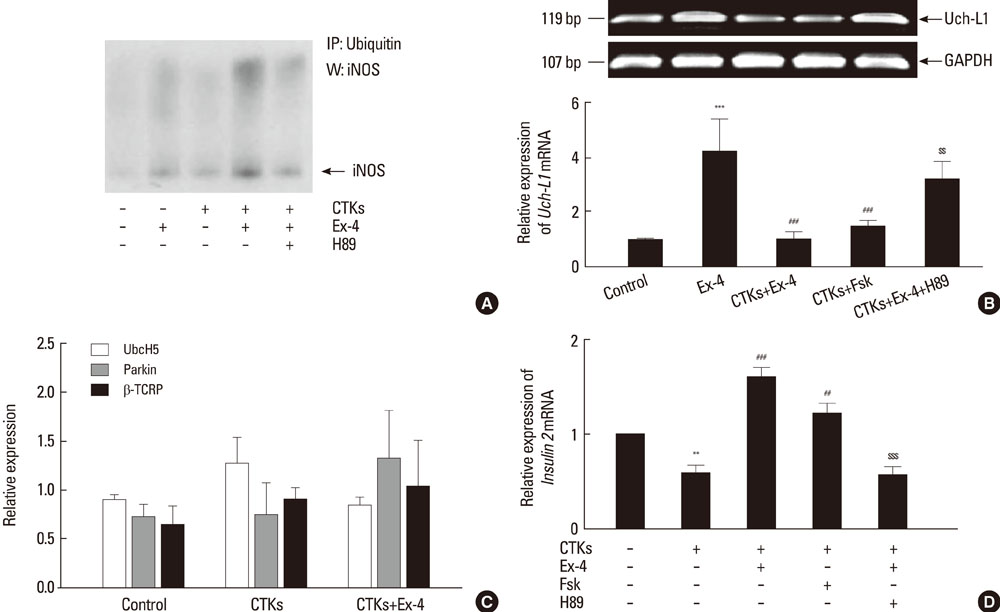Endocrinol Metab.
2011 Jun;26(2):142-149. 10.3803/EnM.2011.26.2.142.
GLP-1 Can Protect Proinflammatory Cytokines Induced Beta Cell Apoptosis through the Ubiquitination
- Affiliations
-
- 1Department of Internal Medicine, Konyang University Myunggok Medical Research Institute, Daejeon, Korea. kbjoon4u@hananet.net
- KMID: 1497721
- DOI: http://doi.org/10.3803/EnM.2011.26.2.142
Abstract
- BACKGROUND
Proinflammatory cytokines are one of the causes of diabetes mellitus. However, the exact molecular mechanism by which proinflammatory cytokines induce beta-cell death remains to be clearly elucidated. Glucagon-like peptide-1 (GLP-1) affects the stimulation of insulin secretion and the preservation of beta-cells. Additionally, it may exert an antiapoptotic effect on beta cells; however, the mechanism underlying this effect has yet to be demonstrated. Therefore, we investigated the protective effects of GLP-1 in endoplasmic reticulum (ER)-mediated beta-cell apoptosis using proinflammatory cytokines.
METHODS
To induce ER stress, hamster insulin-secreting tumor (HIT)-T15 cells were treated using a mixture of cytokines. Apoptosis was evaluated via MTT assay, Hoechst 33342 staining, and annexin/propidium iodide (PI) flow cytometry. The mRNA and protein expression levels of ER stress-related molecules were determined via PCR and Western blotting, respectively. Nitric oxide was measured with Griess reagent. The levels of inducible nitric oxide synthase (iNOS) mRNA and protein were analyzed via real-time PCR and Western blot, respectively. iNOS protein degradation was evaluated via immunoprecipitation. We pretreated HIT-T15 cells with exendin (Ex)-4 for 1 hour prior to the induction of stress.
RESULTS
We determined that Ex-4 exerted a protective effect through nitric oxide and the modulation of ER stress-related molecules (glucose-regulated protein [GRP]78, GRP94, and CCAAT/enhancer-binding protein homologous protein [CHOP]) and that Ex-4 stimulates iNOS protein degradation via the ubiquitination pathway. Additionally, Ex-4 also induced the recovery of insulin2 mRNA expression in beta cells.
CONCLUSION
The results of this study indicate that GLP-1 may protect beta cells against apoptosis through the ubiquitination pathway.
Keyword
MeSH Terms
-
Animals
Apoptosis
Benzimidazoles
Blotting, Western
Cricetinae
Cytokines
Diabetes Mellitus
Endoplasmic Reticulum
Ethylenediamines
Flow Cytometry
Glucagon-Like Peptide 1
HSP70 Heat-Shock Proteins
Immunoprecipitation
Incretins
Insulin
Membrane Proteins
Nitric Oxide
Nitric Oxide Synthase Type II
Polymerase Chain Reaction
Proteolysis
Real-Time Polymerase Chain Reaction
RNA, Messenger
Sulfanilamides
Ubiquitin
Ubiquitination
Benzimidazoles
Cytokines
Ethylenediamines
Glucagon-Like Peptide 1
HSP70 Heat-Shock Proteins
Incretins
Insulin
Membrane Proteins
Nitric Oxide
Nitric Oxide Synthase Type II
RNA, Messenger
Sulfanilamides
Ubiquitin
Figure
Reference
-
1. Ronn SG, Billestrup N, Mandrup-Poulsen T. Diabetes and suppressors of cytokine signaling proteins. Diabetes. 2007. 56:541–548.2. Stoffers DA, Kieffer TJ, Hussain MA, Drucker DJ, Bonner-Weir S, Habener JF, Egan JM. Insulinotropic glucagon-like peptide 1 agonists stimulate expression of homeodomain protein IDX-1 and increase islet size in mouse pancreas. Diabetes. 2000. 49:741–748.3. Kaufman RJ, Scheuner D, Schroder M, Shen X, Lee K, Liu CY, Arnold SM. The unfolded protein response in nutrient sensing and differentiation. Nat Rev Mol Cell Biol. 2002. 3:411–421.4. Kim JY, Lee SK, Baik HW, Lee KH, Kim HJ, Park KS, Kim BJ. Protective effects of glucagon like peptide-1 on HIT-T15 beta cell apoptosis via ER stress induced by 2-deoxy-D-glucose. Korean Diabetes J. 2008. 32:477–487.5. Thomas HE, Darwiche R, Corbett JA, Kay TW. Interleukin-1 plus gamma-interferon-induced pancreatic beta-cell dysfunction is mediated by beta-cell nitric oxide production. Diabetes. 2002. 51:311–316.6. Sarkar SA, Kutlu B, Velmurugan K, Kizaka-Kondoh S, Lee CE, Wong R, Valentine A, Davidson HW, Hutton JC, Pugazhenthi S. Cytokine-mediated induction of anti-apoptotic genes that are linked to nuclear factor kappa-B (NF-kappaB) signalling in human islets and in a mouse beta cell line. Diabetologia. 2009. 52:1092–1101.7. Kharroubi I, Ladriere L, Cardozo AK, Dogusan Z, Cnop M, Eizirik DL. Free fatty acids and cytokines induce pancreatic beta-cell apoptosis by different mechanisms: role of nuclear factor-kappaB and endoplasmic reticulum stress. Endocrinology. 2004. 145:5087–5096.8. Pugazhenthi U, Velmurugan K, Tran A, Mahaffey G, Pugazhenthi S. Anti-inflammatory action of exendin-4 in human islets is enhanced by phosphodiesterase inhibitors: potential therapeutic benefits in diabetic patients. Diabetologia. 2010. 53:2357–2368.9. Cardozo AK, Kruhoffer M, Leeman R, Orntoft T, Eizirik DL. Identification of novel cytokine-induced genes in pancreatic beta-cells by high-density oligonucleotide arrays. Diabetes. 2001. 50:909–920.10. Parkash J. Inflammatory cytokine signaling in insulin producing beta-cells enhances the colocalization correlation coefficient between L-type voltage-dependent calcium channel and calcium-sensing receptor. Int J Mol Med. 2008. 22:155–163.11. Cetkovic-Cvrlje M, Eizirik DL. TNF-alpha and IFN-gamma potentiate the deleterious effects of IL-1 beta on mouse pancreatic islets mainly via generation of nitric oxide. Cytokine. 1994. 6:399–406.12. Kang JH, Chang SY, Jang HJ, Kim DB, Ryu GR, Ko SH, Jeong IK, Jo YH, Kim MJ. Exendin-4 inhibits interleukin-1beta-induced iNOS expression at the protein level, but not at the transcriptional and posttranscriptional levels, in RINm5F beta-cells. J Endocrinol. 2009. 202:65–75.13. Weissman AM. Themes and variations on ubiquitylation. Nat Rev Mol Cell Biol. 2001. 2:169–178.
- Full Text Links
- Actions
-
Cited
- CITED
-
- Close
- Share
- Similar articles
-
- Exendin-4 Protects Oxidative Stress-Induced beta-Cell Apoptosis through Reduced JNK and GSK3beta Activity
- Beta Cells Preservation in Diabetes using GLP-1 and Its Analog
- Protective Effects of Glucagon Like Peptide-1 on HIT-T15 beta Cell Apoptosis via ER Stress Induced by 2-deoxy-D-glucose
- Glucagon-Like Peptide-1 Increases Mitochondrial Biogenesis and Function in INS-1 Rat Insulinoma Cells
- The Production and Correlation of Silica Induced Proinflammatory Cytokines and TGF-beta from Monocytes of Balb/C Mice





